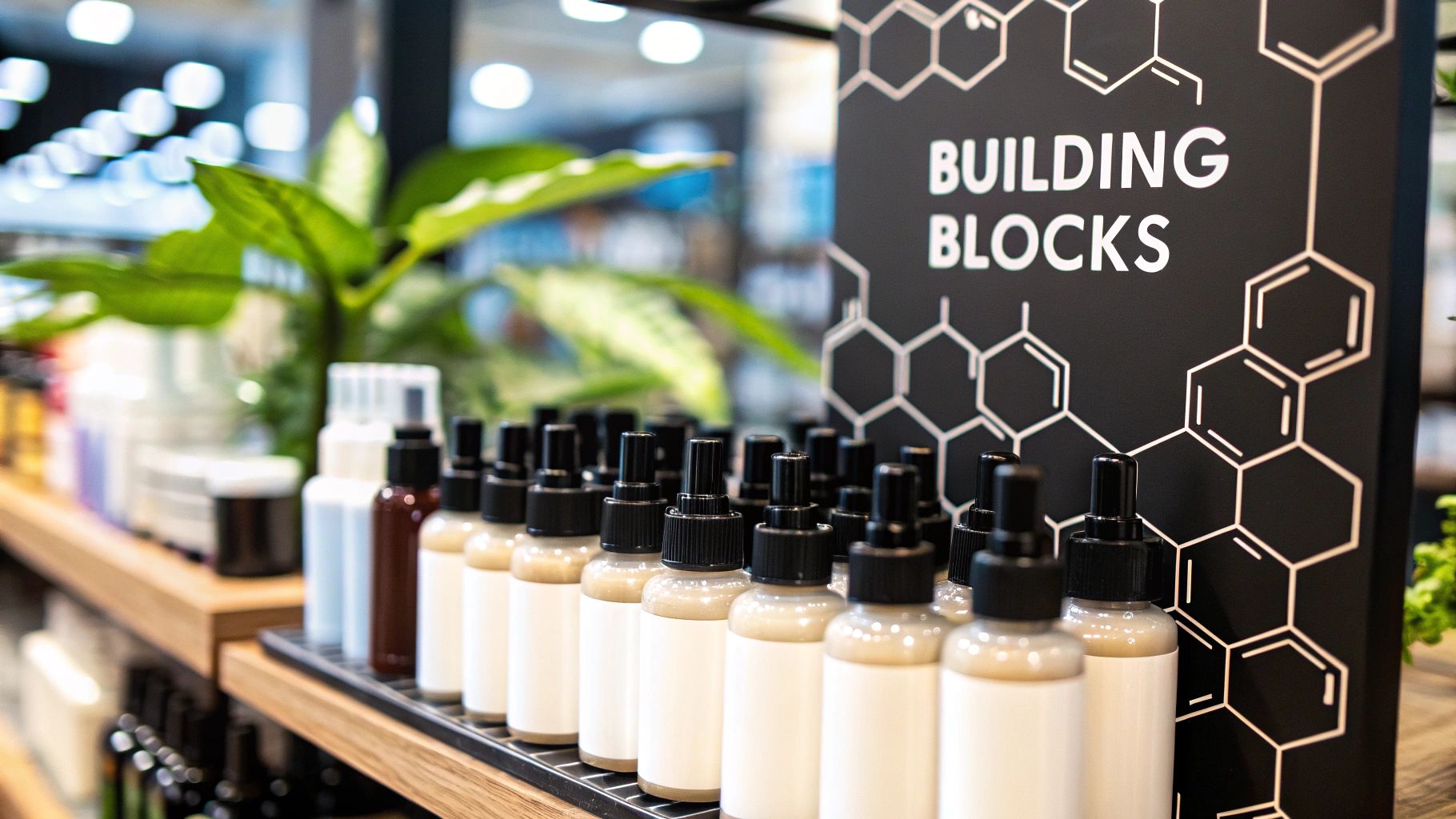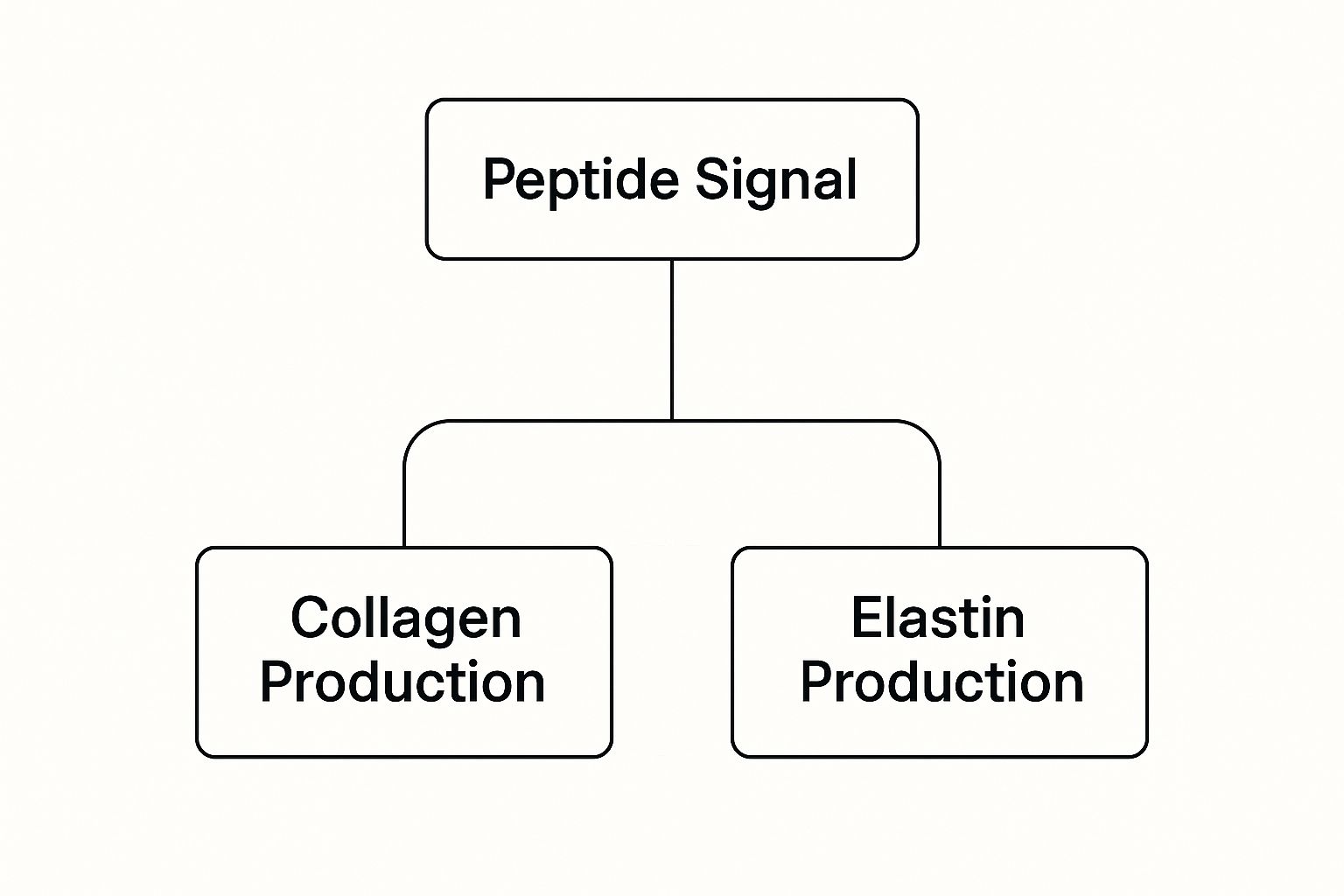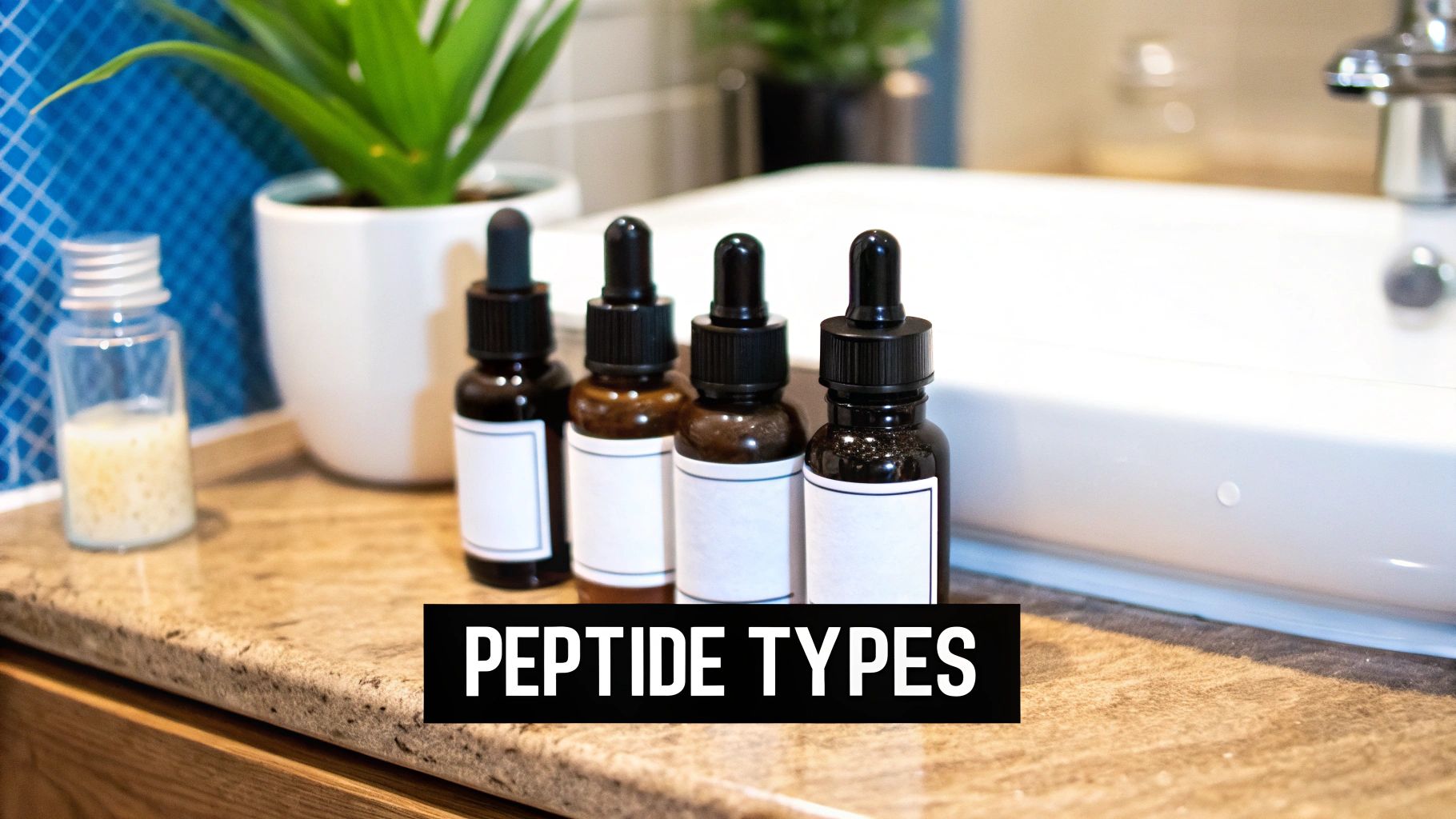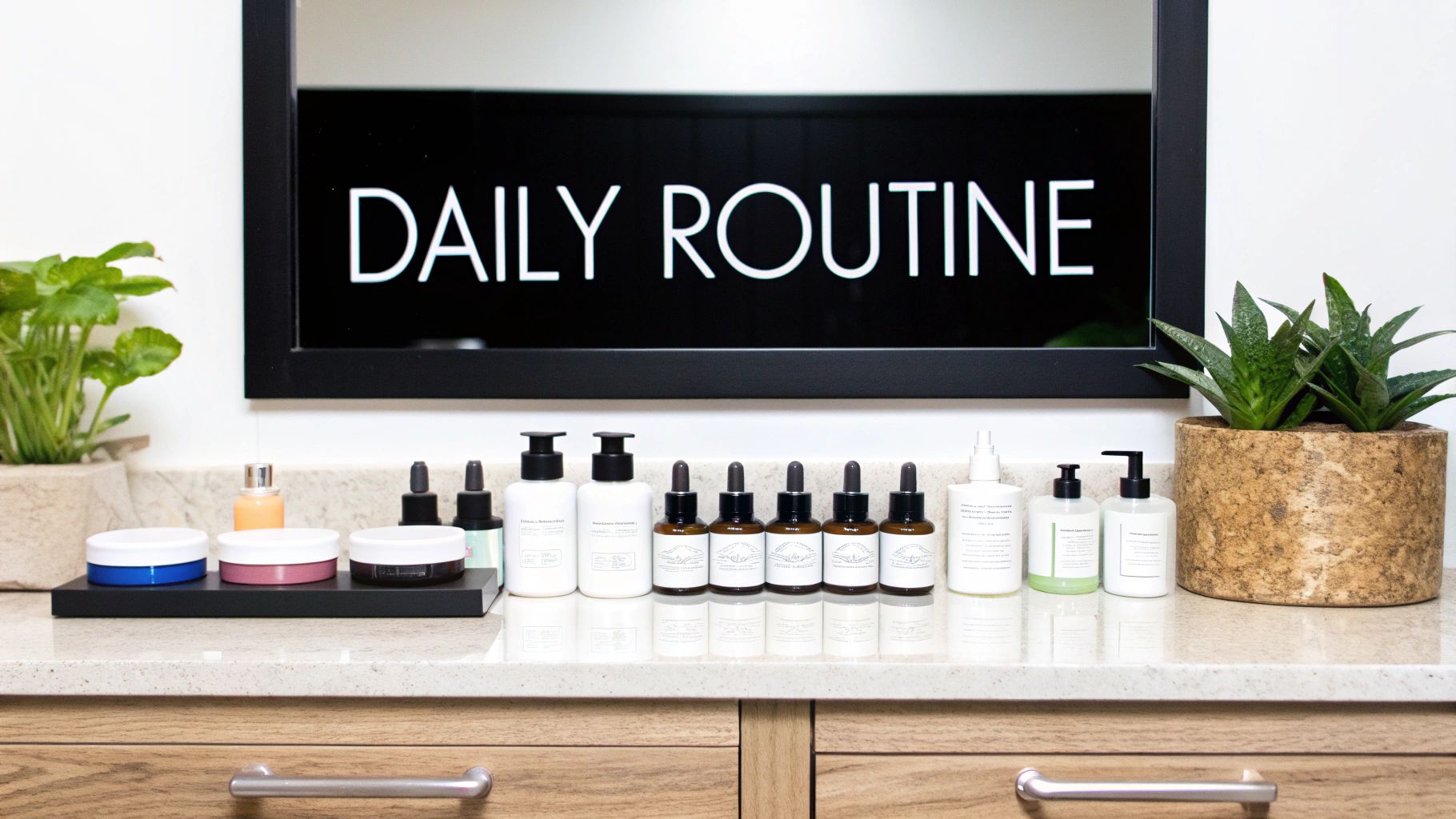What Are Peptides in Skincare? Benefits & Usage Explained
- Blog Admin

- 14 hours ago
- 12 min read
Walking down the skincare aisle can feel like decoding a secret language, with every bottle promising to be the one true fountain of youth. So, let's cut through the noise and talk about one of the most exciting ingredients out there: what are peptides in skincare?
Simply put, think of them as tiny, highly effective messengers for your skin cells. They are short chains of amino acids, which are the fundamental building blocks of proteins. And not just any proteins—we're talking about collagen and elastin, the very duo that gives your skin its firm, plump, and youthful structure.
Your Introduction to Peptides: The Building Blocks of Youthful Skin

As the years go by, our body's natural factory for these crucial proteins starts to slow down. That slowdown is what leads to the fine lines, wrinkles, and loss of firmness we all notice over time. This is exactly where peptides make their grand entrance. When you apply them to your skin, they signal your cells to kick production back into high gear, essentially giving your skin a gentle nudge to remember how it behaved in its prime.
This guide is here to demystify these powerhouse molecules. We'll explore how they work their magic and why they’ve earned their place as a cornerstone of modern skincare. Understanding what they do is particularly vital for those of us dealing with the often harsh and drying Canadian climate, which can unfortunately speed up the signs of ageing.
Why Peptides Are Gaining Popularity
The buzz around peptides isn't just clever marketing; it’s rooted in a real, growing understanding of just how effective they are. The proof is in the numbers, too. The global peptide skincare market is booming, with a significant presence in Canada, driven by our collective awareness of benefits like their anti-ageing effects and ability to improve skin elasticity.
This surge in popularity means you’ll spot peptides in everything from lightweight serums to rich, creamy moisturisers. But knowing how they actually function is the key to picking the product that will truly work for you.
Peptides are not just a surface-level fix; they communicate directly with your skin cells to restore function from within, encouraging the rebuilding of a stronger, more resilient skin structure.
Of course, achieving glowing skin is about more than just one ingredient. A holistic approach that includes broader strategies for graceful aging creates the most impactful and lasting results. By combining targeted ingredients with overall wellness, you’re making a real investment in your skin’s long-term health and vitality—something we’re passionate about helping our clients achieve here in London, Ontario.
How Peptides Send Signals to Rebuild Your Skin
Think of your skin cells as having tiny little docking stations, each waiting for a specific messenger to arrive with instructions. Peptides are those perfect messengers. They’re the ‘key’ designed to fit perfectly into the ‘lock’ of these cell receptors, delivering a very clear command.
When a signal peptide clicks into place, it’s like a wake-up call for your skin's fibroblast cells. It tells them, "Hey, it's time to get back to work!" This command kick-starts the production of more collagen and elastin—the essential proteins that give your skin its strong, flexible foundation.
This whole process is about rebuilding your skin's underlying structure from the inside out. It's not a temporary surface fix; it's direct communication, telling your skin how to act younger and function more efficiently. This is precisely why peptides are a go-to for anyone seeking real, structural improvement.
The Message Peptides Deliver
So, what happens when your cells get the message? You start to see and feel a real difference. Your skin becomes firmer, the texture feels smoother, and those fine lines begin to soften. This isn't just wishful thinking; it's the result of your skin actively rebuilding itself based on the instructions it received.
Different peptides carry different messages, which is what makes them so versatile. Some target wrinkles, while others focus on restoring lost elasticity. This targeted approach allows us to get very specific with skincare solutions. For example, the market for collagen peptides is booming—the United States alone made up about 30.8% of the global market revenue in 2023, with Canada's market also showing strong growth. These specialized peptides are easily absorbed and get right to work, encouraging the skin's own remodelling process. You can dig into more of this data over at Grandview Research.
The infographic below gives you a great visual of how this all plays out. You can see how a single peptide signal directly triggers the production of those vital skin proteins.

It’s a clear cause-and-effect relationship. The peptide provides the catalyst, and the result is more collagen and elastin, leading to healthier, stronger skin.
Amplifying the Signal with Professional Care
While your at-home peptide serums are working diligently day in and day out, professional treatments can really turn up the volume on those rebuilding signals. Here at Skinsation Aesthetics in London, Ontario, we use advanced technologies that work hand-in-hand with your daily routine.
For instance, our Aerolase laser treatment gently warms the deeper layers of your skin. This heat creates a powerful, natural collagen-building response from within, making your skin the perfect environment for your topical peptides to do their best work.
By pairing the daily messaging from peptides with the deep stimulation from a treatment like Aerolase, you're giving your skin a complete rejuvenation strategy. It’s all about building a stronger foundation from the inside out, so your skin stays resilient, firm, and radiant for years to come.
Next up, we'll dive into the different types of peptides you'll find in skincare.
Meet the Different Types of Peptides in Skincare

Once you start looking into peptides, you quickly realise they aren’t a one-size-fits-all ingredient. They're actually a huge family of molecules, and each one has a very specific job to do. Getting to know the different types is the key to finally making sense of product labels and picking a formula that genuinely targets your skin concerns.
Think of it like building a specialized team for your skin. You wouldn’t hire an electrician to fix your plumbing, right? The same logic applies here. To truly get a handle on what peptides bring to your skincare routine, you need to meet the main players. Let’s break down the four most common groups you'll see on ingredient lists.
Signal Peptides: The Collagen Boosters
Signal peptides are probably the most famous of the bunch. Their main gig is to act like little messengers, telling your skin cells it’s time to ramp up collagen and elastin production. As we get older, our natural production of these proteins slows down, and these peptides step in to send a clear signal, basically reminding the skin to firm up and rebuild itself.
These are the foundational workers for anyone looking to tackle fine lines, wrinkles, and that loss of bounce in their skin. By nudging your skin to create its own support structure, they help bring back a more resilient and youthful-looking complexion.
Carrier Peptides: The Mineral Transporters
Next up are the carrier peptides. Just like their name suggests, their job is to safely deliver essential trace minerals—like copper and manganese—directly to your skin cells. These minerals are critical for things like wound healing and, you guessed it, making more collagen.
Copper peptides are a well-known example in this category. By making sure your skin has the raw materials it needs to repair itself, carrier peptides help improve elasticity and overall skin health. They’re the logistics experts of the peptide world, ensuring everything gets where it needs to go.
The real power of peptides lies in their specificity. Each type has a distinct function, allowing for targeted treatments that address everything from wrinkles to protecting your existing collagen reserves.
Neurotransmitter-Inhibiting Peptides: The Line Relaxers
Often nicknamed "Botox in a jar," these peptides work by gently interfering with the nerve signals that cause our facial muscles to contract. Now, this doesn't freeze your muscles. Instead, it just softens the contractions, which helps to relax and smooth out the appearance of expression lines.
They're particularly great for dynamic wrinkles, like the crow’s feet that show up when you smile or the "11s" between your brows. This makes them a fantastic option for anyone wanting to soften those specific lines.
Enzyme-Inhibiting Peptides: The Collagen Protectors
Finally, we have the enzyme-inhibiting peptides. Their whole mission is to protect the precious collagen you already have. They work by slowing down the enzymes that naturally break down your collagen over time—a process that contributes significantly to skin ageing.
By acting as security guards for your skin’s existing structure, these peptides help maintain firmness and prevent future breakdown. They’re all about preserving what you've got, keeping your skin’s foundation strong for as long as possible.
To pull it all together, here’s a quick look at how these different peptide types function and what they do for your skin.
Common Peptide Types and Their Skincare Functions
Peptide Type | Primary Function | Key Skin Benefit |
|---|---|---|
Signal Peptides | Stimulate new collagen production. | Reduces wrinkles and increases firmness. |
Carrier Peptides | Deliver trace minerals for repair. | Improves elasticity and overall skin health. |
Neurotransmitter-Inhibiting Peptides | Soften muscle contractions. | Smooths expression lines and dynamic wrinkles. |
Enzyme-Inhibiting Peptides | Slow collagen breakdown. | Preserves existing firmness and elasticity. |
As you can see, each category plays a unique role. By understanding these differences, you can start choosing products with a mix of peptides that work together to give your skin exactly what it needs.
The Real Benefits of Adding Peptides to Your Routine
Alright, we’ve covered the different types of peptides. Now, let's get past the hype and talk about what you can actually expect to see in the mirror when you start using them. Adding these clever little ingredients to your skincare routine isn't just about wishful thinking; it kicks off a cascade of science-backed improvements for healthier, more resilient skin.
One of the biggest wins you'll notice is a visible reduction in fine lines and wrinkles. By sending signals to ramp up collagen production, peptides help plump and firm your skin right from the inside. Think of it like rebuilding the scaffolding under your skin—it leads to a smoother surface and better elasticity, giving your skin back that youthful bounce.
Strengthening Your Skin's First Line of Defence
Peptides are also fantastic for reinforcing your skin's natural barrier. This protective layer is absolutely essential for locking in moisture and shielding your skin from environmental damage—something we know all too well when navigating the harsh, often dry, Canadian seasons.
A stronger barrier means your skin can hold onto hydration much more effectively, which cuts down on dryness and sensitivity. For those of us here in London, Ontario, battling those cold winter winds or stuffy indoor heating, this benefit is a total game-changer for keeping your complexion healthy and comfortable.
Calming Inflammation and Evening Skin Tone
Beyond just firming things up, certain peptides have some pretty remarkable anti-inflammatory powers. They can help soothe irritation and dial down redness, making them a gentle but powerful choice if you have sensitive or reactive skin.
By calming that underlying inflammation, peptides help create a more even and balanced skin tone. This means less blotchiness and a clearer, more radiant look overall.
This is exactly why peptides aren't just an "anti-ageing" ingredient; they're a core part of a complete skin wellness strategy. Their ability to stimulate collagen and improve skin elasticity makes them a scientifically promising addition to any cosmetic formula. The demand for them is growing steadily across Canada, especially as younger consumers proactively look for these benefits, a trend you can read more about on Precision Business Insights.
If you're looking to build a truly effective anti-ageing regimen, peptides are an excellent place to start. They also play well with other proven ingredients to deliver more comprehensive results. To see how they fit into a bigger picture, check out our guide on the 9 best anti-aging ingredients to use in 2025. Taking this kind of multi-angle approach is the best way to get the amazing skin you're looking for.
How to Use Peptides for the Best Results

Knowing what peptides do is one thing, but actually using them correctly is how you unlock all their incredible benefits. The good news is, weaving these powerful communicators into your daily routine is simple once you get the hang of it. Proper application is all about making sure they can deliver their messages loud and clear to your skin cells.
The most important rule? Placement. Peptides are fantastic team players, but they need an unobstructed path to get where they’re going. Always apply your peptide products onto freshly cleansed and toned skin, before you put on any heavier creams or oils. This gives them direct access for the best possible absorption.
Think of your cleanser and toner as prepping the canvas. Your peptide serum is the artist’s first, most crucial stroke of paint. Heavier products like your moisturizer and sunscreen come last to lock in all that goodness.
Creating the Perfect Peptide Partnership
To really get the most from your peptides, you’ll want to pair them with ingredients that support their mission. They work beautifully alongside hydrating heroes and protective allies.
Hyaluronic Acid: This moisture-magnet creates the perfect hydrated environment for peptides to travel through the skin and do their job effectively.
Antioxidants (like Vitamin C and Niacinamide): These ingredients defend your skin from environmental stressors, freeing up your peptides to focus on what they do best: rebuilding and repairing.
Ceramides: These lipids are fantastic for strengthening your skin’s barrier, which perfectly complements the barrier-boosting benefits of many peptides.
On the flip side, you’ll want to be a bit careful when using peptides with strong acids like AHAs and BHAs. While they don't always clash, high concentrations of acids can sometimes break down peptides and make them less effective. A good rule of thumb is to use them at different times—maybe acids at night and peptides in the morning—to let each ingredient work its magic without interference.
Consistency is the secret weapon. Peptides aren't a one-and-done solution; they deliver cumulative results. Using them every single day, morning and night, is what sends those consistent signals that lead to lasting improvements in your skin's firmness and texture.
For anyone looking to seriously boost the absorption and effectiveness of their skincare, professional treatments can make a huge difference. You can learn more about how procedures like microneedling help your products penetrate deeper in our detailed guide on the Skinsation Microneedling technique. Combining your diligent at-home routine with in-clinic care is an incredibly powerful strategy for reaching your skin goals.
Enhance Your Results with Professional Treatments
While a consistent at-home routine with peptide products is fantastic for daily maintenance, you can seriously amplify their effects with professional treatments right here in London, Ontario. Think of it this way: in-clinic procedures and your daily skincare routine work together, creating a powerful partnership that delivers much more profound and lasting results.
Certain treatments, for example, can dramatically increase how well your skin absorbs your peptide serums. This means the active ingredients you apply after a professional session can get to work more effectively, supporting the skin's rebuilding process on a much deeper level.
Combining Technology with Topical Care
At Skinsation Aesthetics, we often pair your dedicated skincare regimen with the powerful Aerolase laser. This is an advanced, non-invasive treatment that gently heats the dermis to kickstart collagen production from deep within the skin. This process creates the perfect, revitalized foundation for your topical peptides to then support and maintain.
Combining a state-of-the-art treatment like Aerolase with a consistent peptide regimen is our core strategy for achieving visible, comprehensive skin rejuvenation. It’s all about building a better foundation from within and supporting it from the outside.
Our booking page shows the range of services we’ve designed to work hand-in-hand with your home care.
This selection gives you an idea of how different treatments can be combined to target specific concerns, from improving texture to restoring firmness.
To really boost your results, our exclusive Peptide Perfection Peel is specifically formulated to resurface the skin while infusing it with potent, firming peptides. To further amplify your skin's radiance and hydration, you might also consider professional options like advanced skin booster treatments. By layering these professional services with your daily peptide application, you’re creating a multi-faceted approach to skin health that delivers truly exceptional outcomes.
Common Questions We Hear About Peptides
Whenever we start talking about peptides with our clients here in London, Ontario, a few questions always pop up. It makes sense—you want to know what you’re putting on your skin and be confident that it’s actually going to work. Let’s clear up some of the most common queries we get.
First and foremost, are they safe? The fantastic news is that peptides are incredibly gentle. Because they are essentially pieces of the same proteins your skin already makes, your body recognizes them. This means they are very well-tolerated by all skin types, even highly sensitive ones. They work with your skin's natural biology, not against it, which is why irritation is so rare.
Setting Realistic Expectations
Another big one is, "How long until I see a change?" While the hydrating boost from a good peptide serum can feel pretty immediate, the real magic—that plumping, firming, and line-smoothing goodness—takes a bit of patience. You’ll want to use your product consistently for at least four to twelve weeks to see those structural improvements. Think of it as a long-term investment in your skin's health; the results build on themselves over time.
We also get a lot of questions about mixing peptides with other skincare powerhouses, especially retinol.
Absolutely! In fact, peptides and retinol are a dream team. Retinol works on accelerating cell turnover, while peptides are busy rebuilding your skin's support structure. A great way to use them together is to apply your peptide serum first to hydrate and cushion the skin, then follow up with your retinol.
Finally, does a higher price tag guarantee a better product? Not necessarily. What truly matters is the concentration, the specific types of peptides used, and the delivery system that gets them where they need to go. It’s far more important to find a well-formulated product that targets your specific concerns than to just grab the most expensive bottle off the shelf. Making smart, informed choices is what will truly get you that healthy, glowing skin you’re after.
Ready to take your skincare to the next level with expert guidance and advanced treatments? At Skinsation Aesthetics Inc., we create personalized plans to help you achieve your goals. Visit our website to book your consultation today.


Comments